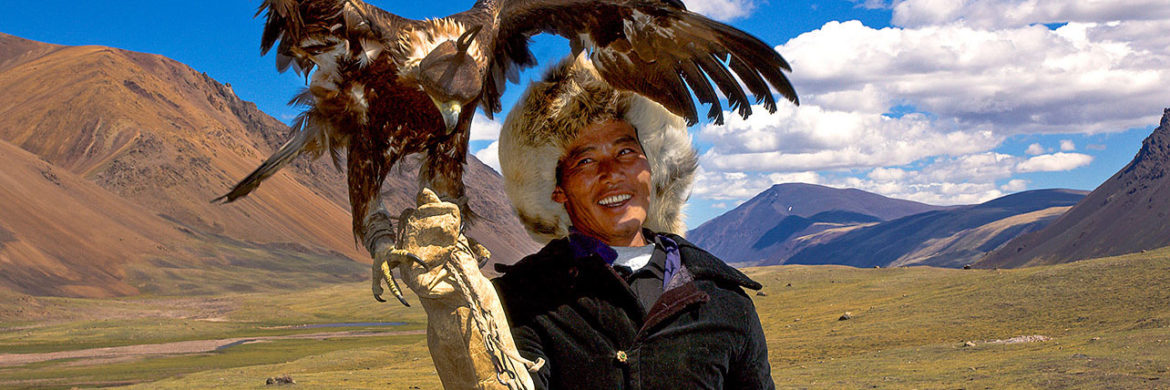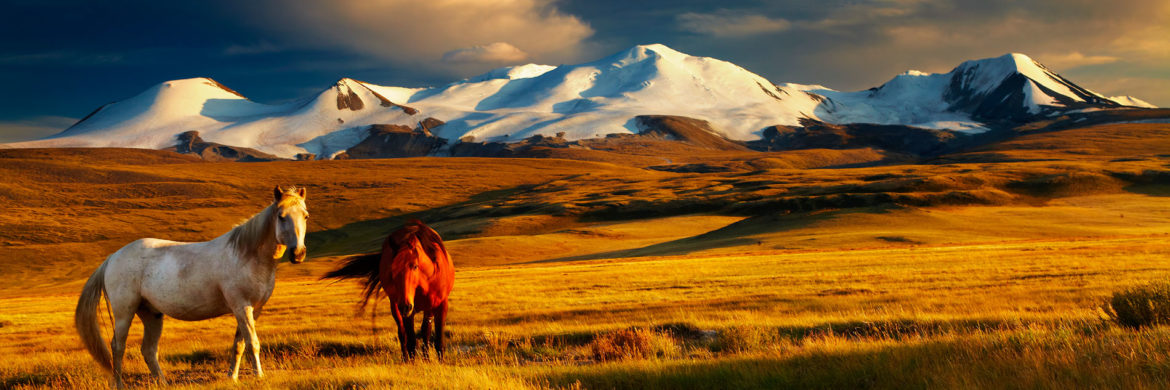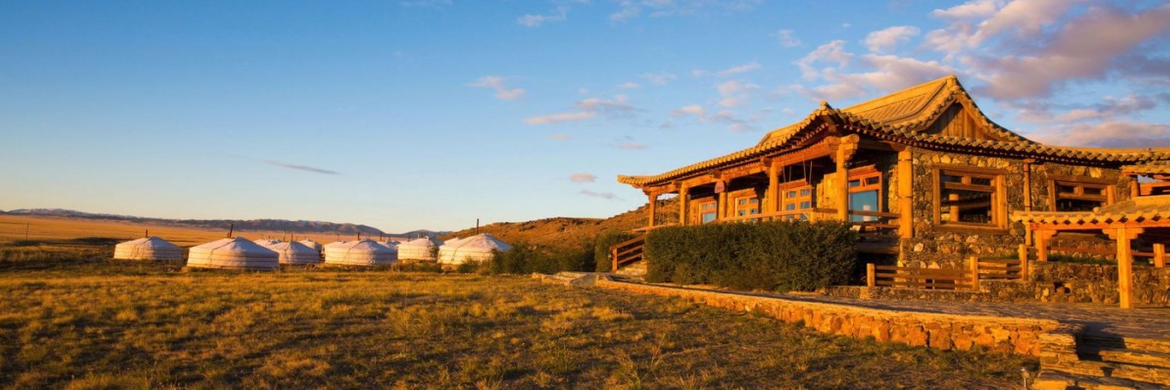Mongolia Escapes
Mongolia, a nation bordered by China and Russia, is known for vast, rugged expanses and nomadic culture. Its capital, Ulaanbaatar, centers around Chinggis Khaan (Genghis Khan) Square, named for the notorious founder of the 13th- and 14th-century Mongol Empire. Also in Ulaanbaatar are the National Museum of Mongolia, displaying historic and ethnographic artifacts, and the restored 1830 Gandantegchinlen Monastery.
Mongolia is a vast country of stark beauty, extreme weather and exceedingly warm people, who still revere the legendary Genghis Khan, who conquered much of the known world from his Mongolian base. Mongolia is the size of western Europe with fewer than three million people, and it is the single most sparsely populated nation on earths, but with one of the fastest growing economies. Mongolians have traditionally been nomadic herdsmen — and half the people still are, living in round felt tents called gers that are moved regularly from place to place. There is great contrast between the capital city of Ulaanbaatar with its fancy restaurants and shops, and the rest of the country which holds on firmly to its traditional culture.
Huge gorges, sweeping planes, rich steppes, crystalline lakes and mountains topped in snow are just some of Mongolia’s many attractions. With communism and Soviet influence now but a memory, democratic Mongolia offers access to its Buddhist past. There are temples such as the Erdene Zuu monastery – the first Buddhist monastery in Mongolia – as well as the Bogd Khaan Palace. Various ruins include the famous Karakorum (the ancient capital of Mongolia founded by Genghis Khan), Khitan and Ongiin Khiid. Mongolia’s natural realm will surprise you with its diversity. Fishing, camping and long treks on horseback and camel are but some of the possibilities for the traveler.
ULAANBAATAR
Anchored between past and present, the capital city of Ulaanbaatar is redefining itself in an exciting new world with massive investment money flowing in for the rapidly growing mining and minerals industry. Ulaanbaatar’s tiny stock exchange located right on the central Sukhbatar Square is one of the world’s fastest growing bourses. Echoes of its Communist past reverberate through Ulaanbaatar, as Soviet-era architecture and signs in Cyrillic sit alongside glass-and-steel hotels and shopping centers, with traditional Buddhist temples just steps away. Ulaanbaatar serves as a gateway to Mongolia’s fabled lands, but with its tremendous contrast between old and new is in and of itself a fascinating jumping off point to the rest of the country.
GOBI DESERT
Forbidding and expansive, the Gobi Desert is the largest desert in Asia and easily visible from space. From Silk Road caravans to modern day movies, the Gobi Desert has figured prominently in the popular imagination. Savor the harsh beauty of the Gobi from atop a camel; visit the dramatic, multicolored Flaming Cliffs; share a meal with a nomadic family, whose way of life has remained unchanged for decades; or simply savor views of the night sky, clear and unpolluted by light, noise, and human activity. The South Gobi requires a flight to Dalanzadgad, but areas of the North Gobi can be reached by a four hour car ride from Ulaanbaatar.
HUSTAI NATIONAL PARK
Hustai National Park is a land of arid steppe, forest, and gentle slopes located just 2-3 hours by car west of Ulaanbaatar. Hustai is home to Mongolia’s last remaining population of wild horses, the rare and critically endangered Przewalski’s Horse, which was successfully reintroduced to the preserve after having been extinct in the wild since the 1960’s. Hikes through the unspoiled wilderness here offer opportunities to see the gorgeous wild horses and other wildlife as well as large birds such as falcons and eagles.
LAKE HOVSGOL
Clear and pristine, Lake Hovsgol is one of the finest and most pristine bodies of water in all of Asia. It is also one of the clearest lakes in the world, and is nicknamed Mongolia’s “Dark Blue Pearl”. The lake is ringed by forests, rocky shores, and the nearby Ikh Uul Mountain, a 10,000 foot tall peak that offers panoramic views of the surrounding countryside. It is set in a spectacular landscape of Siberian taiga with the Horidal Saridag Mountain Range to the west.
- Camel Trek – Go on a camel trek in the northern Gobi Desert for a taste of life as a nomadic herder. Meet friendly herdsmen along the way, who will invite you into their gers to learn about their lives.
- Flaming Cliffs – Flaming Cliffs in the South Gobi is a famed archaeological site, so named because of their vibrant glowing orange appearance in the sunlight. The cliffs are a dramatic landscape of jagged red rocks that is rich in fossils – the first fossilized dinosaur eggs were unearthed here in the 1920s by the expedition of Roy Chapman Andrews, and velociraptor remains have also been uncovered nearby.
- Sand Dunes – Much of the Gobi Desert is steppe and scrub, but there are several areas in the South Gobi, such as Hongor Els, “The Singing Sands”, and the smaller Moltsog Els, near Three Camel Lodge, as well as stretches of dunes in the North Gobi driving distance from Ulaanbaatar.
- Black Market – Explore the Naraan Tuul Market, also known as the Black Market (open everyday except Tuesday). Not quite as illicit as the name suggests, this huge bazaar sells just about everything, from camping gear to riding saddles, handicrafts to antiques.
- Ger Restaurant – Dine at Ger Restaurant, housed within a large, decorated ger, or Mongolian tent. Your meal will be followed by a performance of traditional Mongolian folk music, including throat singing, a traditional style of music found across central Asia.
- Museum of Natural History – Visit the Museum of Natural History, whose star attraction is a complete dinosaur skeleton – the giant, 50- foot long carnivorous Tarbosaurus. This is an actual skeleton unearthed in the Gobi Desert – not a replica like at so many other museums. The museum also has a small Velociraptor skeleton and a striking painting of a 26-foot tall duck-billed herbivore, Saurolophus.
- Naadam Festival – Every July the spectacular Naadam festival takes place in Ulaanbaatar, with competitions featuring The Three Manly Sports of archery, wrestling, and horseback riding. Naadam originated from military parades and folk celebrations. However, it now commemorates the 1921 revolution in which Mongolia declared itself a free country.
- Winter Palace of the Bogd Khan – Explore the Winter Palace of the Bogd Khan, the only remaining residence of the last emperor of Mongolia, who died in 1924. The complex includes six temples and displays many possessions of the Bogd Khan, including a large ceremonial ger, his throne, and a pair of boots given to him by Tsar Nicholas II of Russia.
- Museum of Fine Arts – Have a privately guided tour of the Zanabazar Museum of Fine Arts, led by an expert in Mongolian history. Part of UNESCO’s Programme for the Preservation of Endangered Movable Cultural Properties and Museum Development.
- Bird watching & Wildlife Hikes – Hike through Hustai National Park’s rolling, hilly steppes and birch forests. The park’s ridges offer look-out points with spectacular vistas, and be sure to keep your eyes open for the red deer, red-footed falcons, and eagles that also call the park home.




